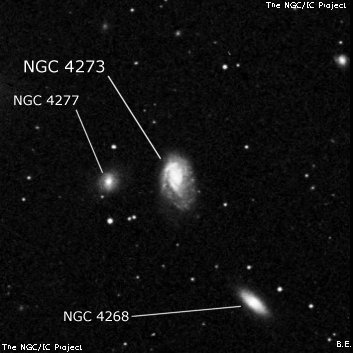
William Herschel discovered NGC 4273 = H II-569 = h1183 = h1189 on 17 Apr 1786 (sweep 553) and recorded "Four [NGC 4270, 4273, 4277 and 4281], the time and number is that of the last [NGC 4281]. They are scattered about." There is nothing near his position, but exactly one degree south is[NGC 4281, the last of the 4 bright galaxies. Because of WH's error, JH recorded the nebula as a "nova" (h1189) on 27 Dec 1827, but his RA was ~40 sec too large. On a later sweep, he recorded it as a nova again (h1183) and measured an accurate position. Dreyer combined these identities together in the NGC.
400/500mm - 17.5" (3/28/87): fairly bright, moderately large, elongated 3:2 ~N-S, bright core. Forms a close pair with NGC 4277 2' ESE. Brightest in a group of 7 galaxies with NGC 4281 6' ENE, NGC 4268 3.8' SW and NGC 4270 7.5' N.
600/800mm - 24" (4/28/14): bright, moderately large, elongated 2:1 N-S, 1.6'x0.8', well concentrated, brighter along the major axis (bar?). Among numerous NGC galaxies including NGC 4277 2' E, NGC 4268 4' SW, NGC 4281 7' NE, NGC 4270 7.5' N and NGC 4259 9' WNW.
Notes by Steve Gottlieb